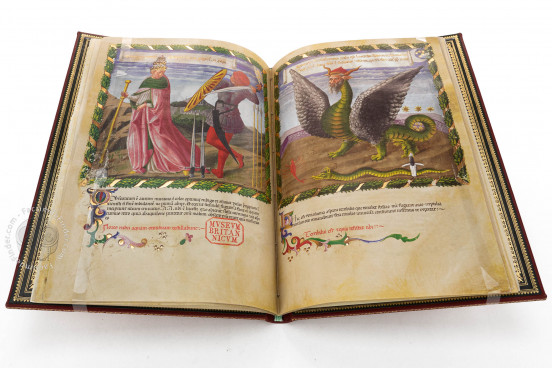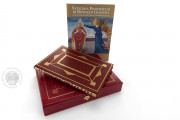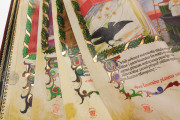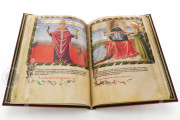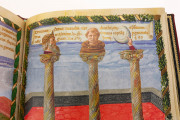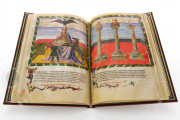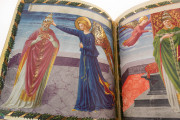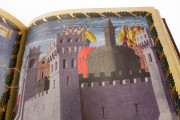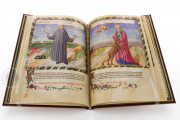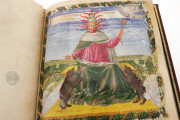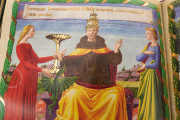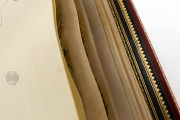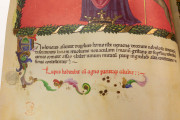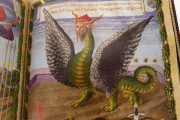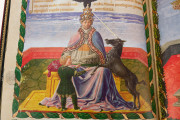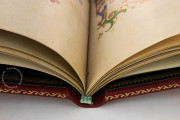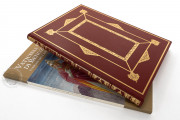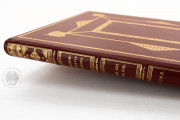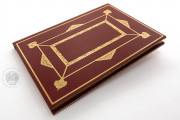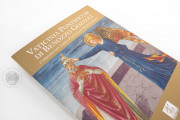The Harley Vaticinia de Pontificibus is at once a picture book of Roman Catholic popes and a series of moralizing verses about the trajectory of the papacy: corruption will be met by divine intervention, leading to a holy regime. The manuscript was created during the papacy of Eugene IV (second quarter of the fifteenth century), presumably in Florence. Its thirty splendid miniatures have been attributed to Benozzo Gozzoli, famous in his own time for his frescoes.
The subjects of the miniatures include individual popes, usually accompanied by an animal or other attribute; cities (fols. 12r-12v); a nearly naked man approached by a boy (fol. 13v); and a series of scenes picturing the coronation of a future "angelic" pope (fols. 14r-15r).
A Parade of Pontiffs
Twenty-three miniatures are portraits of popes of the thirteenth, fourteenth, and fifteenth centuries. Most are shown in a luxuriant cope and wearing the papal three-tiered crown standing on a parapet with a colored marble floor in front of an atmospheric landscape. An inscription written in gold on a banderole that appears to float in the sky identifies each pope (although the banderole on fol. 13r is blank).
Signs and Symbols
The papal portraits include a myriad of creatures—bears, dragons, wolves, roosters, doves, a dog, a peacock, a scorpion, a snake, a unicorn, a crow—and objects—a severed head, a chalice, a flagellum, a sickle, a severed leg. These were and are difficult to interpret. Most were understood in early modern Italy to represent people or events related to the pictured pope. For example, the wolf pulling the ribbon of Pope Celestine V's tiara was interpreted as the cardinal who forced the pope's abdication (fol. 3r).
Benozzo Gozzoli
The manuscript's miniatures are attributed to Benozzo di Lese (d. 1497), known since the sixteenth century as Benozzo Gozzoli ("Benozzo goiters"), a painter trained by Fra Angelico, who worked in Florence, Rome, and other Italian cities. His style is marked by meticulous attention to detail, especially apparent in his depictions of the various animals and objects that identify the individual popes in the Harley manuscript.
Perfectly Balanced Pages
A square miniature with a painted garland frame occupies three-quarters of each page. Below is a discreet prophecy, written in black, and a motto, written in red. The texts are written in a clear Gothic Rotunda with few abbreviations. The main text on each page, written in full and starting with a majuscule letter in black, is introduced by a redundant painted initial with a foliated extender of blue, green, red, lavender, and gold.
A Mysterious Text of Complicated Origin
Developed from an original series of fifteen cryptic sayings in Latin verse about Catholic cardinals dating from before 1292, the Vaticinia de summis pontificibus (Predictions concerning the Highest Pontiffs) combines those original verses with another fifteen in the same style composed in the mid-fourteenth century. As with most medieval "prophetic" texts, some predictions concerned persons who had already lived at the time of composition (known as post eventum predictions).
In the Original Collection of the British Museum
Either Robert Harley (1661-1724), Earl of Oxford, or his son, Edward Harley (1689-1741), Earl of Oxford, seems to have acquired the book in 1720. Their collection of manuscripts was sold by Edward's widow, Margaret Cavendish Harley (1715-1785), Duchess of Portland, to the state at the establishment of the British Museum. The manuscript was transferred to the British Library in 1973.
We have 1 facsimile edition of the manuscript "Harley Vaticinia de Pontificibus": Vaticinia Pontificum de Benozzo Gozzoli facsimile edition, published by Patrimonio Ediciones, 2017
Request Info / Price
